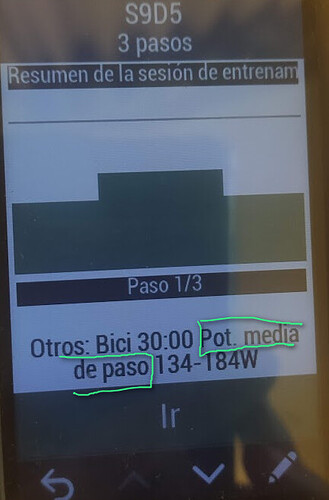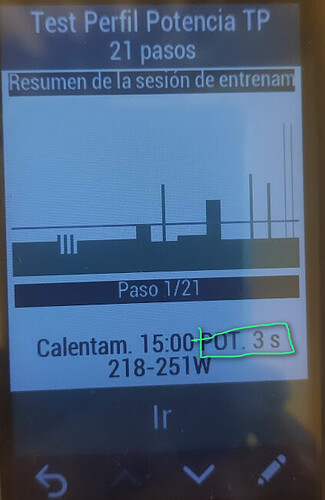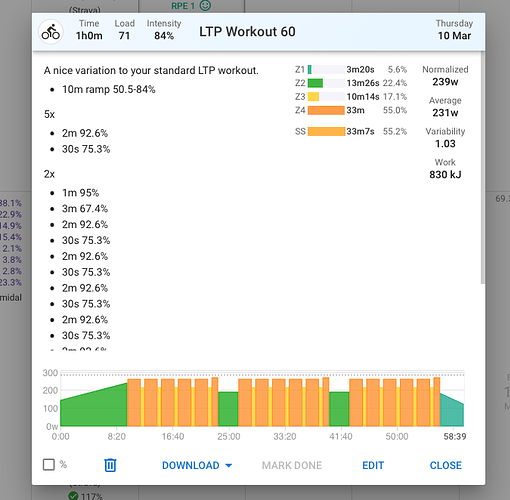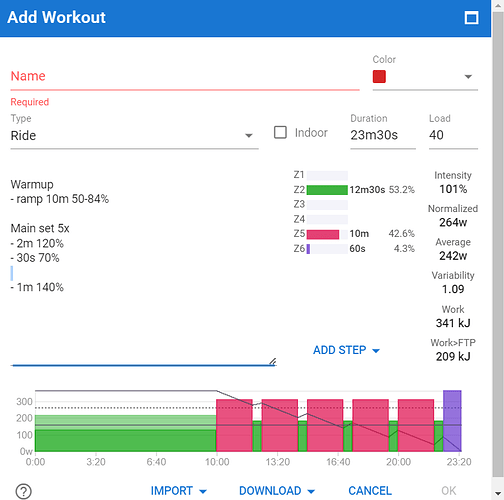I think that was the original intention of Trainer Day (originally ERG DB). I use both Intervals.icu and Trainer Day and the API integration works pretty well. But having an Intervals.icu group/folders would be a great addition too.
The idea and implementation of turning short text workout descriptions into a structured workout is brilliant…so much easier and faster than using graphical workout builders. And it seems to really open the door to integration and extension since it is text-based.
Anyway - new subscriber here - just wanted to add a vote for a few of the ideas in this thread.
- adding distance-based workout intervals to the workout builder (for all sports, but run and swim especially). You have said this is hard, but so many existing workouts are done by distance instead of by time for running and swimming. Just curious - is it hard because of how intervals.icu is designed, or because distance is harder than time, or some combination?
EDIT: whoops, I see that pace and HR are implemented.
It’s only hard because all the workout code starts with time. So lots to change!
There are also some complicates in that the load, time etc. will now all depend on which athlete is using the workout.
Is anyone else having the issue where the Description field is no longer populated in downloaded files?
I’ve created workouts and then downloaded them in ERG, ZWO and MRC formats but the "DESCRIPTION = " field in the downloaded files is always blank.
I recall doing the same steps previously and never had an issue.
Ah I have fixed this. Broke it a little while ago. Tx.
Thanks David!
It works now for individual files but I’ve found when doing a bulk download of a plan the descriptions are still blank.
By ‘bulk download’ I mean when you have the library open and you select ‘download’ for a full plan.
I’ve tested individual download of each within a plan and that’s fine, it’s just not filling the description field when downloading them all as a zip
When a workout is synced to my Garmin calendar, I get this:

and in my garmin 1030 plus device each training interval is characterized by “average step power”, when it would be desirable for each interval to be characterized by “average power 3s”.
Is there any way to change this?
when I create a workout with training peaks it is automatically characterized by “average power 3s”, but not in Intervals.icu
Hi there,
Trying to build my first workout but only seeing plane text and no colour coded diagram below. Any suggestions , I have screenshot of a workout I downloaded from a team mate.
Thanks
Sean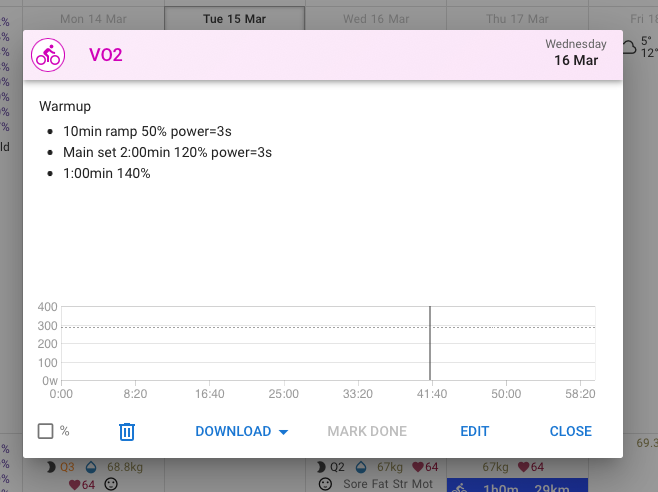
I think you have to use 10m iso 10min, 2m iso 2:00min and for a ramp you need start and end % like 50-70%. Syntax hes to be correct.
As @MedTechCD has already mentioned, syntax is important.
Your workout you wanted to create needs to look similar to this:
- ramp duration %power (when using ramp it needs to have a start and end value)
Main set x5 <— the x5 gives you the interval sets.
Recovery in between needs to be the same too; specify the duration and %power
Leave a space allows you to add one interval (purple) and not repeat it after every red.
The “Add Step” button is helpful when you are still learning the syntax. You can just fill in the dialog and it will generate the text.
Thanks for that I’ll give it a shot, appreciated the help.
Ok ill use that, appreciate input thanks.
Ok ill keep an eye on that, thanks for help
Does Ramp functionality actually means anything in the workout builder?
How does one “ramp” a HR?
I understand it looks “nice” on the workout builder graphic, but I’m really trying to wrap my head around the practical functionality of it.
I’m trying to parse the JSON for these HR only workouts and these HR Ramps are messing w/ my head. Practically, all HR targets should either be a range or a Higher/Lower target shouldn’t it?
The only thing I can think of is the ramp graphic is just to depict to users that they should be trying to increase their HR to the higher target.
thanks
When Intervals.icu generates workouts for Garmin and Suunto it converts the ramp into a range even for power. For Zwift, MRC and ERG it generates a ramp.
I have fixed the ramp in the JSON output, will deploy in a couple of hours.
Thanks… my goal is to have as seamless as possible the experience between the platforms such that workouts gets executed in similar fashion.
correct me if I’m wrong, but I think what you’re saying is, a power ramp like
1m ramp 50-80%
will still be a ramp for power based workouts (w/ ramp keyword) but a workout that doesn’t include the word ramp (but has a range)
1m 50-80%
will be converted to the average of the range (for MRC / ERG / ZWIFT workouts). These behaviour is similar w/ Garmin / Suunto as well ? Even for workouts that connects to the indoor turbo?
For HR based workouts, you’re saying that all HR Ramps like
1m ramp 50-80% HR
will still be converted to a range and there will be no ramp correct?
How can I get these output files such that I can make my verification such that my parsing/displaying etc is similar. (i don’t know how to get the Garmin / Suunto workout formats etc)
eg: would like to see how this is parsed for Suunto/Garmin as MRC/ERG/Zwift file downloads basically is empty as this is HR based ride.
which gets parsed as - hence my trepidation soleby based on the Graphic. (HR is always a Range of values - meaning as long as user is within the range, they are OK, but the graphic looks like this which is very different from intervals.icu)
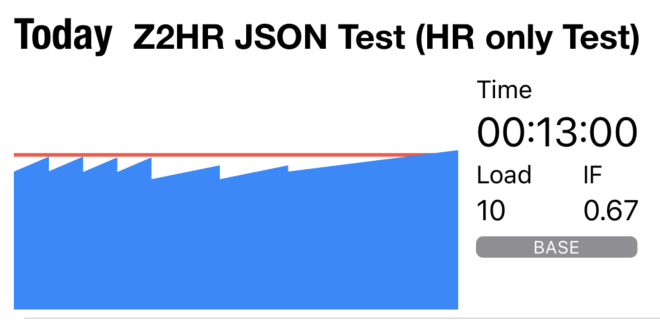
TQ.
ps: TQ for the fix you’re soon to apply. 
A HR ramp is different than a range. A ramp is a gradual increase in cardiac output and oxygen saturation within body in anticipation of higher/more work. It also means that there is an increase in body heat. Both are usually accompanied with an increase in RR. Just as soup in a pot is slowly warmed to allow ingredients to cook and flavours to be released, so too the body ought to be treated. Putting the soup or body on high heat without proper preparation and warming leads to scalding, early fatigue and injury. Instead, allow the fluids to decrease in viscosity allowing for distribution of nutrition and oxygen, as well as the removal of waste. Jumping quickly from low HR to higher HR makes it difficult for the local muscles to keep up with the work being asked of them. In the same manner, a decreasing ramp at the end of a session facilitates the recovery process.
IME, many people ramp far too quickly, impatient to “get on with it”, and don’t cool down properly.
A range is an estimated percentage of workload. It is a way of describing the anticipated output for a given energy system or targeted fibre type. However, responses vary from day to day dependant upon many factors. If all mind and body are firing on all cylinders and if all life stressors are low then one may be able to absorb more load. Inversely, there are days when the body is stressed at a much lower loads. A range allows the athlete to listen to the body and work within the bounds of available resources.
Garmin and Suunto don’t support ramps (as far as I know from the docs) for power or HR. So I generate a range and the device will tell you if you are within the bounds. I don’t know what Garmin does if you are controlling a trainer (maybe uses the average?). You could use the text to tell the athlete to gradually increase power or HR.
Zwift, MRC and ERG do support ramps so they get them but they also only do power.
Interavls.icu renders a range with solid colour up to the min and then a lighter colour to the max. Same for HR, power and pace.
The fix is live now. Sorry for breaking your stuff!

